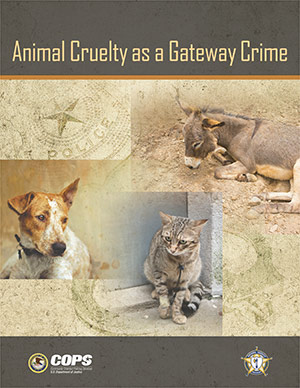Contact Us
To provide feedback on the Community Policing Dispatch, e-mail the editorial board at CPDispatch@usdoj.gov.
To obtain details on COPS Office programs, publications, and resources, contact the COPS Office Response Center at 800-421-6770 or AskCopsRC@usdoj.gov

U.S. Department of Justice
Office of Community Oriented Policing Services
Washington, DC 20530
The stories are heartbreaking—a small Chihuahua tied up and kicked around like a soccer ball, an emaciated horse with a deep wound to his hind leg—and as numerous as they are sickening to hear. What’s more, these cases of animal cruelty and neglect are often precursors or accompaniments to acts of extreme violence against humans as well.
Intentional Animal Torture and Cruelty (IATC) offences frequently begin in childhood or adolescence. Its psychological roots are usually in antisocial or psychopathic personality disorders.1 Though it is often an expression of rage, IATC is also used as a tool to coerce, control, and intimidate human targets—usually family members, including children and the elderly. Abusers punish their victims by tormenting their pets, or threaten beloved animals with cruelty in order to gain victims’ compliance or silence.
 Precursors to Violent Crime and Accompaniments to Domestic Abuse
Precursors to Violent Crime and Accompaniments to Domestic Abuse
Reprehensible in themselves, these acts are almost always precursors to violent crime directed at humans. Researchers have connected children’s abuse of animals to bullying, aggression, school shootings, and sexual abuse. Through these activities, children who feel powerless torment their own victims to gain a sense of control and power for themselves. Moreover, FBI research indicates that most serial killers, school shooters, and mass murderers tortured animals as children.
Another form of abuse, dogfighting, is also tied to criminal behavior beyond the harm to the animals. In addition to illegal gambling, dogfights are often accompanied by illegal drugs and weapons, assaults, and even homicides, often involving gang members.
Class A Crimes Requiring Response and Prosecution
In every state, animal cruelty is a crime, requiring response and prosecution; in 2014 the FBI announced that it would upgrade it to a class A crime. The public is fully supportive of law enforcement response and prosecution—in fact, dispatchers report that calls from witnesses to animal cruelty are often very emotional. Invariably, these community members are horrified and perceive the problem as a crime requiring police response.
But most importantly, these crimes are windows into the home, indicators of domestic abuse and other criminal activities, as well as windows into the psyche, providing opportunities to prevent future crime by directing early abusers into appropriate social services.
The challenge of how to detect IATC, respond to, and prevent it was addressed at a 2015 forum on Animal Cruelty as a Gateway Crime, hosted by the National Sheriff’s Association in partnership with the COPS Office and the National Coalition on Violence Against Animals. The discussion focused on the often overlooked correlation between IATC and other serious crimes as well as the need for comprehensive officer training in all aspects of animal cruelty and methods for detecting it.
Recognizing the Signs of Cruelty and Neglect
Meeting participants noted that officers can learn to recognize the indicators of cruelty or criminal neglect. In addition to abnormal behavior—such as extreme aggression or shyness—and obvious signs of trauma, these indicators include lack of food, water, or sanitation. If the animal is caged or tied up so closely it cannot stand, especially if chains or locks are embedded in its skin, or it is left in an abandoned property, the animal is being neglected or abused. The presence of too many dogs on the property could be a sign of dogfighting.
Officers responding to calls for domestic abuse should keep in mind that if pets are present, they may be mistreated too, and look for the same indicators as those above. It would be helpful to ask the individuals in the home, including the children, what happens if their pets misbehave, if their pet is healthy, and other questions that can reveal abuse or neglect of family members as well as their pets. Officers can document these indicators through photography or interviews, and call for a forensic veterinarian to collect evidence.
In all cases, detection, response, and prosecution of these crimes is critical—not only to end the suffering of helpless animals, but to prevent the commission of additional or future crimes by their tormentors. IATC is the gateway to acts of extreme, remorseless violence, and must be as vigorously addressed as any other crime.
Faye Elkins
Sr. Technical Writer
For more information:
Animal Cruelty
Animal Cruelty as a Gateway Crime
Dogfighting: Community Action Guide
References:
1.Mark Griffiths, “The Psychology of Animal Torture,” In Excess [blog], Nov 23, 2016, Psychology Today, https://www.psychologytoday.com/us/blog/in-excess/201611/the-psychology-animal-torture.
Subscribe to Email Updates
To sign up for monthly updates or to access your subscriber preferences, please enter your email address in the Subscribe box.






